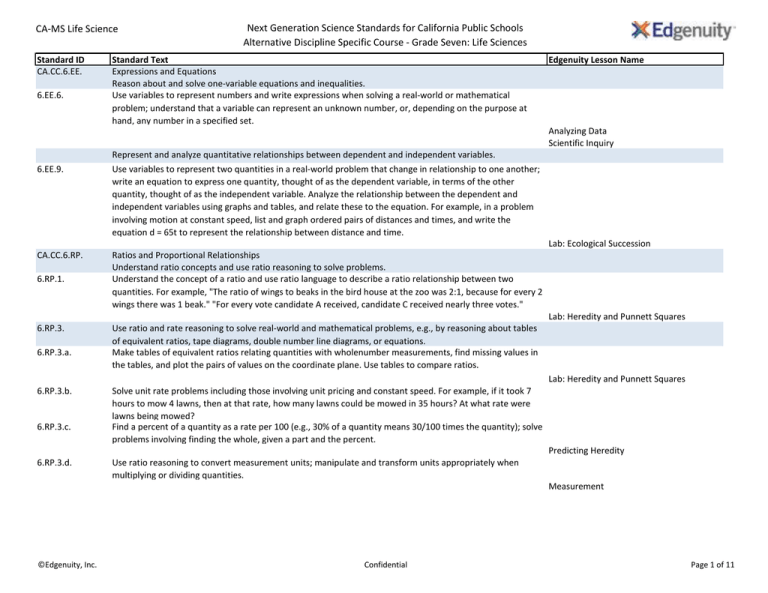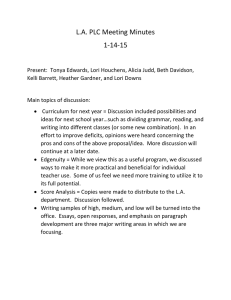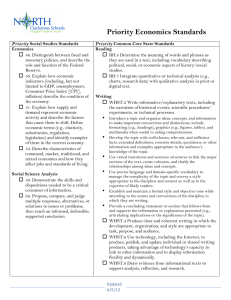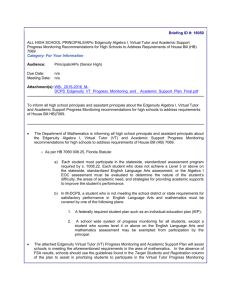CA-MS Life Science Next Generation Science Standards for
advertisement

CA-MS Life Science Standard ID CA.CC.6.EE. 6.EE.6. Next Generation Science Standards for California Public Schools Alternative Discipline Specific Course - Grade Seven: Life Sciences Standard Text Expressions and Equations Reason about and solve one-variable equations and inequalities. Use variables to represent numbers and write expressions when solving a real-world or mathematical problem; understand that a variable can represent an unknown number, or, depending on the purpose at hand, any number in a specified set. Edgenuity Lesson Name Analyzing Data Scientific Inquiry 6.EE.9. Represent and analyze quantitative relationships between dependent and independent variables. Use variables to represent two quantities in a real-world problem that change in relationship to one another; write an equation to express one quantity, thought of as the dependent variable, in terms of the other quantity, thought of as the independent variable. Analyze the relationship between the dependent and independent variables using graphs and tables, and relate these to the equation. For example, in a problem involving motion at constant speed, list and graph ordered pairs of distances and times, and write the equation d = 65t to represent the relationship between distance and time. Lab: Ecological Succession CA.CC.6.RP. 6.RP.1. Ratios and Proportional Relationships Understand ratio concepts and use ratio reasoning to solve problems. Understand the concept of a ratio and use ratio language to describe a ratio relationship between two quantities. For example, "The ratio of wings to beaks in the bird house at the zoo was 2:1, because for every 2 wings there was 1 beak." "For every vote candidate A received, candidate C received nearly three votes." Lab: Heredity and Punnett Squares 6.RP.3. 6.RP.3.a. Use ratio and rate reasoning to solve real-world and mathematical problems, e.g., by reasoning about tables of equivalent ratios, tape diagrams, double number line diagrams, or equations. Make tables of equivalent ratios relating quantities with wholenumber measurements, find missing values in the tables, and plot the pairs of values on the coordinate plane. Use tables to compare ratios. Lab: Heredity and Punnett Squares 6.RP.3.b. 6.RP.3.c. Solve unit rate problems including those involving unit pricing and constant speed. For example, if it took 7 hours to mow 4 lawns, then at that rate, how many lawns could be mowed in 35 hours? At what rate were lawns being mowed? Find a percent of a quantity as a rate per 100 (e.g., 30% of a quantity means 30/100 times the quantity); solve problems involving finding the whole, given a part and the percent. Predicting Heredity 6.RP.3.d. Use ratio reasoning to convert measurement units; manipulate and transform units appropriately when multiplying or dividing quantities. Measurement ©Edgenuity, Inc. Confidential Page 1 of 11 CA-MS Life Science Standard ID CA.CC.6.SP. 6.SP.2. Next Generation Science Standards for California Public Schools Alternative Discipline Specific Course - Grade Seven: Life Sciences Standard Text Statistics and Probability Develop understanding of statistical variability. Understand that a set of data collected to answer a statistical question has a distribution which can be described by its center, spread, and overall shape. Edgenuity Lesson Name Analyzing Data 6.SP.4. Summarize and describe distributions. Display numerical data in plots on a number line, including dot plots, histograms, and box plots. 6.SP.5. 6.SP.5.a. Summarize numerical data sets in relation to their context, such as by: Reporting the number of observations. 6.SP.5.b. Describing the nature of the attribute under investigation, including how it was measured and its units of measurement. 6.SP.5.c. Giving quantitative measures of center (median and/or mean) and variability (interquartile range and/or mean absolute deviation), as well as describing any overall pattern and any striking deviations from the overall pattern with reference to the context in which the data were gathered. 6.SP.5.d. Relating the choice of measures of center and variability to the shape of the data distribution and the context in which the data were gathered. CA.CC.7.EE. Expressions and Equations Solve real-life and mathematical problems using numerical and algebraic expressions and equations. Solve multi-step real-life and mathematical problems posed with positive and negative rational numbers in any form (whole numbers, fractions, and decimals), using tools strategically. Apply properties of operations to calculate with numbers in any form; convert between forms as appropriate; and assess the reasonableness of answers using mental computation and estimation strategies. For example: If a woman making $25 an hour gets a 10% raise, she will make an additional 1/10 of her salary an hour, or $2.50, for a new salary of $27.50. If you want to place a towel bar 9 3/4 inches long in the center of a door that is 27 1/2 inches wide, you will need to place the bar about 9 inches from each edge; this estimate can be used as a check on the exact computation. Analyzing Data Lab: Ecological Succession Lab: Ecological Succession Lab: Ecological Succession Lab: Ecological Succession 7.EE.3. Lab: Natural Selection ©Edgenuity, Inc. Confidential Page 2 of 11 CA-MS Life Science Standard ID CA.CC.7.SP. 7.SP.7. 7.SP.7.a. Next Generation Science Standards for California Public Schools Alternative Discipline Specific Course - Grade Seven: Life Sciences Standard Text Statistics and Probability Investigate chance processes and develop, use, and evaluate probability models. Develop a probability model and use it to find probabilities of events. Compare probabilities from a model to observed frequencies; if the agreement is not good, explain possible sources of the discrepancy. Develop a uniform probability model by assigning equal probability to all outcomes, and use the model to determine probabilities of events. For example, if a student is selected at random from a class, find the probability that Jane will be selected and the probability that a girl will be selected. Edgenuity Lesson Name Analyzing Data Predicting Heredity 7.SP.7.b. Develop a probability model (which may not be uniform) by observing frequencies in data generated from a chance process. For example, find the approximate probability that a spinning penny will land heads up or that a tossed paper cup will land open-end down. Do the outcomes for the spinning penny appear to be equally likely based on the observed frequencies? Analyzing Data Predicting Heredity CA.CC.MP. MP.2. Mathematical Practices Reason abstractly and quantitatively. MP.4. Model with mathematics. CA.MS-ETS. MS-ETS1. ENGINEERING DESIGN Engineering Design Students who demonstrate understanding can: Define the criteria and constraints of a design problem with sufficient precision to ensure a successful solution, taking into account relevant scientific principles and potential impacts on people and the natural environment that may limit possible solutions. Asexual and Sexual Reproduction Lab: Natural Selection MS-ETS1-1. Technological Design MS-ETS1-2. Evaluate competing design solutions using a systematic process to determine how well they meet the criteria and constraints of the problem. Biodiversity Technological Design MS-ETS1-3. Analyze data from tests to determine similarities and differences among several design solutions to identify the best characteristics of each that can be combined into a new solution to better meet the criteria for success. MS-ETS1-4. Develop a model to generate data for iterative testing and modification of a proposed object, tool, or process such that an optimal design can be achieved. Technological Design Biodiversity Technological Design ©Edgenuity, Inc. Confidential Page 3 of 11 CA-MS Life Science Standard ID CA.MS-LS. MS-LS1. MS-LS1-1. Next Generation Science Standards for California Public Schools Alternative Discipline Specific Course - Grade Seven: Life Sciences Standard Text LIFE SCIENCE From Molecules to Organisms: Structures and Processes Students who demonstrate understanding can: Conduct an investigation to provide evidence that living things are made of cells; either one cell or many different numbers and types of cells. Edgenuity Lesson Name Bacteria Cell Theory Characteristics of Life Fungi Lab: Exploring Cells Protists MS-LS1-2. Develop and use a model to describe the function of a cell as a whole and ways parts of cells contribute to the function. Animal and Plant Cells Cell Cycle Cell Structure Cellular Interactions with the Environment Cellular Respiration Genetic Code Lab: Building Proteins from RNA Lab: Exploring Cells Meiosis Photosynthesis MS-LS1-3. Use argument supported by evidence for how the body is a system of interacting subsystems composed of groups of cells. Body Organization and Homeostasis The Circulatory and Respiratory Systems The Digestive and Excretory Systems The Immune System The Musculoskeletal and Integumentary Systems The Nervous and Endocrine Systems The Reproductive System ©Edgenuity, Inc. Confidential Page 4 of 11 CA-MS Life Science Standard ID MS-LS1-4. Next Generation Science Standards for California Public Schools Alternative Discipline Specific Course - Grade Seven: Life Sciences Standard Text Use argument based on empirical evidence and scientific reasoning to support an explanation for how characteristic animal behaviors and specialized plant structures affect the probability of successful reproduction of animals and plants respectively. Edgenuity Lesson Name Angiosperms Animal Behavior Gymnosperms Lab: Earthworm Behavior Lab: Flower Dissection Overview of Animals Overview of Plants Plant Responses MS-LS1-5. Construct a scientific explanation based on evidence for how environmental and genetic factors influence the growth of organisms. DNA Mutations Genetic Code Inheritance Patterns Introduction to Heredity Lab: Heredity and Punnett Squares Lab: Natural Selection Natural Selection Populations Predicting Heredity MS-LS1-6. Construct a scientific explanation based on evidence for the role of photosynthesis in the cycling of matter and flow of energy into and out of organisms. Cycles of Matter Energy Flow in Ecosystems Photosynthesis MS-LS1-7. Develop a model to describe how food is rearranged through chemical reactions forming new molecules that support growth and/or release energy as this matter moves through an organism. Building Blocks of Life The Digestive and Excretory Systems MS-LS1-8. Gather and synthesize information that sensory receptors respond to stimuli by sending messages to the brain for immediate behavior or storage as memories. The Nervous and Endocrine Systems ©Edgenuity, Inc. Confidential Page 5 of 11 CA-MS Life Science Standard ID MS-LS2. MS-LS2-1. Next Generation Science Standards for California Public Schools Alternative Discipline Specific Course - Grade Seven: Life Sciences Standard Text Ecosystems: Interactions, Energy, and Dynamics Students who demonstrate understanding can: Analyze and interpret data to provide evidence for the effects of resource availability on organisms and populations of organisms in an ecosystem. Edgenuity Lesson Name Biodiversity Cycles of Matter Energy Flow in Ecosystems Living Things and the Environment Populations MS-LS2-2. Construct an explanation that predicts patterns of interactions among organisms across multiple ecosystems. Biomes Energy Flow in Ecosystems Interactions among Living Things Lab: Interdependence of Organisms Lab: Owl Pellets MS-LS2-3. Develop a model to describe the cycling of matter and flow of energy among living and nonliving parts of an ecosystem. Cycles of Matter Energy Flow in Ecosystems MS-LS2-4. Construct an argument supported by empirical evidence that changes to physical or biological components of an ecosystem affect populations. Human Impact on the Environment Lab: Ecological Succession Natural Environmental Change Succession MS-LS2-5. Evaluate competing design solutions for maintaining biodiversity and ecosystem services. CA.MS-LS. MS-LS3. LIFE SCIENCE Heredity: Inheritance and Variation of Traits Students who demonstrate understanding can: Develop and use a model to describe why structural changes to genes (mutations) located on chromosomes may affect proteins and may result in harmful, beneficial, or neutral effects to the structure and function of the organism. Biodiversity MS-LS3-1. DNA Mutations ©Edgenuity, Inc. Confidential Page 6 of 11 CA-MS Life Science Standard ID MS-LS3-2. Next Generation Science Standards for California Public Schools Alternative Discipline Specific Course - Grade Seven: Life Sciences Standard Text Develop and use a model to describe why asexual reproduction results in offspring with identical genetic information and sexual reproduction results in offspring with genetic variation. Edgenuity Lesson Name Asexual and Sexual Reproduction Cell Cycle Inheritance Patterns Introduction to Heredity Lab: Heredity and Punnett Squares Meiosis Predicting Heredity MS-LS4. MS-LS4-1. Biological Evolution: Unity and Diversity Students who demonstrate understanding can: Analyze and interpret data for patterns in the fossil record that document the existence, diversity, extinction, and change of life forms throughout the history of life on Earth under the assumption that natural laws operate today as in the past. Evidence for Evolution The Fossil Record The Theory of Evolution MS-LS4-2. Apply scientific ideas to construct an explanation for the anatomical similarities and differences among modern organisms and between modern and fossil organisms to infer evolutionary relationships. MS-LS4-3. Analyze displays of pictorial data to compare patterns of similarities in the embryological development across multiple species to identify relationships not evident in the fully formed anatomy. MS-LS4-4. Construct an explanation based on evidence that describes how genetic variations of traits in a population increase some individuals' probability of surviving and reproducing in a specific environment. Evolutionary Relationships Evidence for Evolution Natural Selection MS-LS4-5. Gather and synthesize information about the technologies that have changed the way humans influence the inheritance of desired traits in organisms. MS-LS4-6. Use mathematical representations to support explanations of how natural selection may lead to increases and decreases of specific traits in populations over time. CA.CC.RI.6. Reading Standards for Information Text Integration of Knowledge and Ideas Trace and evaluate the argument and specific claims in a text, distinguishing claims that are supported by reasons and evidence from claims that are not. Advances in Genetics Lab: Natural Selection RI.6.8. Evaluating Scientific Explanations ©Edgenuity, Inc. Confidential Page 7 of 11 CA-MS Life Science Standard ID CA.CC.RI.8. RI.8.8. Next Generation Science Standards for California Public Schools Alternative Discipline Specific Course - Grade Seven: Life Sciences Standard Text Reading Standards for Information Text Integration of Knowledge and Ideas Delineate and evaluate the argument and specific claims in a text, assessing whether the reasoning is sound and the evidence is relevant and sufficient; recognize when irrelevant evidence is introduced. Edgenuity Lesson Name Evaluating Scientific Explanations CA.RST.6-8. RST.6-8.1. Reading Standards for Literacy in Science and Technical Subjects Key Ideas and Details Cite specific textual evidence to support analysis of science and technical texts. Characteristics of Life RST.6-8.2. Determine the central ideas or conclusions of a text; provide an accurate summary of the text distinct from prior knowledge or opinions. Evolutionary Relationships RST.6-8.4. Craft and Structure Determine the meaning of symbols, key terms, and other domain-specific words and phrases as they are used in a specific scientific or technical context relevant to grades 6-8 texts and topics. Cell Structure Classification of Living Things Dichotomous Keys Lab: Dichotomous Keys RST.6-8.7. Integration of Knowledge and Ideas Integrate quantitative or technical information expressed in words in a text with a version of that information expressed visually (e.g., in a flowchart, diagram, model, graph, or table). RST.6-8.8. Distinguish among facts, reasoned judgment based on research findings, and speculation in a text. RST.6-8.9. Compare and contrast the information gained from experiments, simulations, video, or multimedia sources with that gained from reading a text on the same topic. CA.CC.SL.8. Speaking and Listening Standards Comprehension and Collaboration Engage effectively in a range of collaborative discussions (one-on-one, in groups, and teacher-led) with diverse partners on grade 8 topics, texts, and issues, building on others’ ideas and expressing their own clearly. Come to discussions prepared, having read or researched material under study; explicitly draw on that preparation by referring to evidence on the topic, text, or issue to probe and reflect on ideas under discussion. Animal and Plant Cells Populations Human Impact on the Environment SL.8.1. SL.8.1.a. The Nervous and Endocrine Systems ©Edgenuity, Inc. Confidential Page 8 of 11 CA-MS Life Science Standard ID SL.8.1.b. SL.8.1.c. SL.8.1.d. SL.8.4. SL.8.4.a. SL.8.5. CA.WHST.6-8. WHST.6-8.1. WHST.6-8.1.a. WHST.6-8.1.b. WHST.6-8.1.c. WHST.6-8.1.d. WHST.6-8.1.e. ©Edgenuity, Inc. Next Generation Science Standards for California Public Schools Alternative Discipline Specific Course - Grade Seven: Life Sciences Standard Text Edgenuity Lesson Name Follow rules for collegial discussions and decision-making, track progress toward specific goals and deadlines, and define individual roles as needed. The Nervous and Endocrine Systems Pose questions that connect the ideas of several speakers and respond to others' questions and comments with relevant evidence, observations, and ideas. The Nervous and Endocrine Systems Acknowledge new information expressed by others, and, when warranted, qualify or justify their own views in light of the evidence presented. The Nervous and Endocrine Systems Presentation of Knowledge and Ideas Present claims and findings (e.g., argument, narrative, response to literature presentations), emphasizing salient points in a focused, coherent manner with relevant evidence, sound valid reasoning, and well-chosen details; use appropriate eye contact, adequate volume, and clear pronunciation.CA Plan and present a narrative that: establishes a context and point of view, presents a logical sequence, uses narrative techniques (e.g., dialogue, pacing, description, sensory language), uses a variety of transitions, and provides a conclusion that reflects the experience. CA The Nervous and Endocrine Systems Integrate multimedia and visual displays into presentations to clarify information, strengthen claims and evidence, and add interest. Cell Structure Writing Standards for Literacy in Science and Technical Subjects Text Types and Purposes Write arguments focused on discipline-specific content. Introduce claim(s) about a topic or issue, acknowledge and distinguish the claim(s) from alternate or opposing claims, and organize the reasons and evidence logically. Advances in Genetics Support claim(s) with logical reasoning and relevant, accurate data and evidence that demonstrate an understanding of the topic or text, using credible sources. Advances in Genetics Use words, phrases, and clauses to create cohesion and clarify the relationships among claim(s), counterclaims, reasons, and evidence. Advances in Genetics Establish and maintain a formal style. Advances in Genetics Provide a concluding statement or section that follows from and supports the argument presented. Advances in Genetics Confidential Page 9 of 11 CA-MS Life Science Standard ID WHST.6-8.2. WHST.6-8.2.a. Next Generation Science Standards for California Public Schools Alternative Discipline Specific Course - Grade Seven: Life Sciences Standard Text Edgenuity Lesson Name Write informative/explanatory texts, including the narration of historical events, scientific procedures/ experiments, or technical processes. Introduce a topic clearly, previewing what is to follow; organize ideas, concepts, and information into broader categories as appropriate to achieving purpose; include formatting (e.g., headings), graphics (e.g., charts, tables), and multimedia when useful to aiding comprehension. Lab: Owl Pellets WHST.6-8.2.b. Develop the topic with relevant, well-chosen facts, definitions, concrete details, quotations, or other information and examples. Lab: Owl Pellets WHST.6-8.2.c. Use appropriate and varied transitions to create cohesion and clarify the relationships among ideas and concepts. WHST.6-8.2.d. Use precise language and domain-specific vocabulary to inform about or explain the topic. WHST.6-8.2.e. Establish and maintain a formal style and objective tone. WHST.6-8.2.f. Provide a concluding statement or section that follows from and supports the information or explanation presented. Lab: Owl Pellets Lab: Owl Pellets Lab: Owl Pellets Lab: Owl Pellets WHST.6-8.7. Research to Build and Present Knowledge Conduct short research projects to answer a question (including a self-generated question), drawing on several sources and generating additional related, focused questions that allow for multiple avenues of exploration. Biodiversity WHST.6-8.8. Gather relevant information from multiple print and digital sources (primary and secondary), using search terms effectively; assess the credibility and accuracy of each source; and quote or paraphrase the data and conclusions of others while avoiding plagiarism and following a standard format for citation. CA WHST.6-8.9. Draw evidence from informational texts to support analysis reflection, and research. The Nervous and Endocrine Systems Biodiversity Advances in Genetics Asexual and Sexual Reproduction Biodiversity Biomes Cellular Interactions with the Environment Cellular Respiration DNA Mutations Evolutionary Relationships Fungi Human Impact on the Environment ©Edgenuity, Inc. Confidential Page 10 of 11 CA-MS Life Science Standard ID WHST.6-8.9. ©Edgenuity, Inc. Next Generation Science Standards for California Public Schools Alternative Discipline Specific Course - Grade Seven: Life Sciences Standard Text Draw evidence from informational texts to support analysis reflection, and research. (Cont'd.) Confidential Edgenuity Lesson Name Lab: Dichotomous Keys Lab: Earthworm Behavior Lab: Heredity and Punnett Squares Lab: Interdependence of Organisms Lab: Natural Selection Lesson Plant Responses Technological Design The Digestive and Excretory Systems The Immune System The Nervous and Endocrine Systems Page 11 of 11



